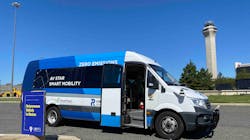PANYNJ launches autonomous vehicle shuttle van pilot project
The Port Authority of New York and New Jersey (PANYNJ) has launched a month-long pilot project that features a driverless shuttle van in operation at Newark Liberty International Airport. The pilot project marks the first time an autonomous vehicle (AV) is operating on public roads in the state of New Jersey, as PANYNJ continues to test new technology to improve efficiency, reliability and safety across its facilities.
The pilot project is being conducted in partnership with STV and Perrone Robotics, which responded to an agency solicitation earlier in the year to address what PANYNJ says is “so-called last-mile transit challenges”, where commuters seek short-length transportation options to reach destinations. PANYNJ notes the AVs could allow for faster and more reliable connections, such as a supplement to bus service for two busy points on the Newark airport campus: The new Terminal A and the nearest Air Train station at the P2 parking facility.
“Being the first to bring driverless vehicles to New Jersey roads is the latest example of the Port Authority pushing the envelope when it comes to keeping the region moving,” said PANYNJ Chairman Kevin O’Toole. “The goal is always a streamlined, modern and more convenient journey. If new technology can help get us there, we’re willing to explore it.”
“For more than a hundred years, the Port Authority has been defined by technological and engineering breakthroughs and now we’re putting the computerized pedal to the metal,” said PANYNJ Executive Director Rick Cotton. “Innovation needs to be a major pillar in utilizing 21st century technology to provide the quality of public services the region deserves.”
The AV pilot at Newark Liberty International Airport is being conducted through the PANYNJ's innovation hub, a new collaborative initiative for employees from across departments and disciplines to test cutting-edge products or technology. The Newark pilot is the latest iteration of other AV tests at the agency’s airports, two of which had focused on the safe use of autonomous platooned vehicles on closed roads at John F. Kennedy International Airport in 2022 and earlier in 2023.
For the pilot, a 14-passenger Green Power AV-Star shuttle was retrofitted with autonomous driving technology from Perrone Robotics, including sensors, cameras and mapping functionalities. It was first tested on a safety course that included simulated car and pedestrian obstacles within a closed parking lot at the airport. It then moved to nighttime testing on airport roads between the airport’s P2 Air Train/parking facility and the new Terminal A, where it navigated arrival roadways, complex merges and multiple traffic lights. The shuttle was also tested in mixed traffic during daytime hours.
Throughout the testing period, the shuttle did not pick up passengers and always traveled at a maximum speed of 35 miles per hour and a safety driver on board. In preparation for the pilot, PANYNJ approved a mandated safety plan from all firms involved that focused on safety features, the responsibility of the on-board safety driver and on operational coordination among the pilot project team, the autonomous shuttle company, and the airport.
“We are thrilled to mark this milestone for the state of New Jersey representing a historic moment as the first public road autonomous operation in the state,” said Perrone Robotics CEO Paul Perrone. “This FMVSS-compliant, zero-emissions all-electric mini-bus has been designed to operate autonomously at posted roadway speeds, offering a sustainable and efficient solution for the future of mobility. This is just the beginning and we're excited about the potential this holds for reshaping the transportation landscape.”
The pilot project was organized in conjunction with the New Jersey governor’s office, the New Jersey Department of Transportation and the New Jersey Motor Vehicle Commission, with additional involvement from New Jersey Transit, the New Jersey Economic Development Authority and local municipalities, including Newark and Jersey City.
PANYNJ has also tested autonomous technology on platooned commuter buses last summer to travel faster through the Lincoln Tunnel’s Exclusive Bus Lane, with the goal of leveraging emerging technology to improve speed, efficiency and reliability.
